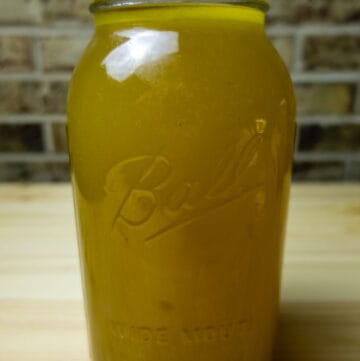
Instant Pot Chicken Stock
This golden stock will be a staple in your kitchen when you make it. Turn vegetable scraps and leftover chicken bones into nutritious stock for soups, stews, and sauces.
Print Recipe
Equipment
- Instant Pot with inner pot
- Fine Mesh Strainer
- Large Bowl
- 2 Half Gallon Mason Jars or 4 quart jars
- Funnel
Ingredients
- Leftover chicken carcass including all bones, skin, and cartilage
- Vegetable scraps peels, and ends (celery, garlic, onion, carrot, tomato, pepper)
- If using whole vegetables use one onion, one carrot, and two celery stalks.
- Aromatics fresh herbs such as rosemary, thyme, oregano, bay leaves, etc
- Whole peppercorns
- 2 TBS Apple cider vinegar
- Optional: salt. I don’t like to salt mine so that I can control the salt when I’m using it to cook a recipe.
Instructions
Preparation
- Gather your chicken bones, vegetable scraps, aromatics, and spices
- If using frozen vegetable scraps, there is no need to thaw, just make sure everything fits in the inner pot.
- If using fresh vegetables, make sure things are cut into manageable pieces so you can extract the most out of them. An inch thick is a good size.
Using the Instant Pot
- Place chicken bones and skins in the bottom on the pot, then the vegetables, herbs and aromatics, and spices
- Add enough filtered cold water to come up just under the Max Fill Line. It was about 12 cups of water for me
- Add 2 tablespoons of apple cider vinegar to the pot and give is a little stir. Let it sit for 15 minutes to begin to draw nutrients out of the bones and scraps.
Pressure Cooking
- Secure the lid onto the Instant Pot
- Place the pressure valve release to Sealing
- Plug the Instant Pot in and set to Manual Pressure to High Pressure
- Set timer for 1 hour
Natural Release
- Once the timer has gone off, unplug the Instant Pot and let it come down in a natural pressure release. Wait for the floating pressure gauge to drop before attempting to open it.
- This recipe is mostly water and if you attempt to do a quick pressure release, a stream of boiling hot stock is going to shoot out of that pressure valve all over you and your kitchen.
- The stock will still be extremely hot when you open it so allow it to sit opened for about 15 minutes to become easier to work with.
- Set up your large bowl with a fine mesh sieve over it.
- Ladle the stock into the strainer
- If it gets too full, use the back of your ladle to press down on the vegetables and bones to extract more liquid. Then discard the bones and scraps into the garbage can
- Continue to do this step until the entire pot is strained
Notes
Storing Stock
- Set up your mason jar with a funnel over it
- Ladle the hot stock into the jars allowing for a little headspace for expansion
- Put a lid on the jars and leave them on the counter to cool before placing in your refrigerator
- Use within 7 days
- Use any vegetable scraps you have on hand. Before I make stock, I go through my refrigerator and look for anything that is past its prime. I’ve used garlic bulbs, wrinkly ginger and cherry tomatoes, carrot numbs, chopped up onions that are starting to get a little soft, you name it.
- Don't use lettuces, squashes, cucumbers, or cruciferous vegetables like broccoli. Anything with a lot of water isn't going to impart flavor and would just be a waste of ingredients. And broccoli or cauliflower is just going to give it a weird aroma and flavor.
- You can store the stock in the refrigerator for up to 7 days or freeze it for 3 months. I like to freeze it in ice cube trays or silicone molds to be able to pull it out and use a measured amount without having to let an entire block of stock thaw.
Nutrition
Calories: 0.4kcal | Carbohydrates: 0.02g | Sodium: 0.1mg | Potassium: 1mg | Sugar: 0.01g | Calcium: 0.1mg | Iron: 0.004mg
Servings: 16 cups
Calories: 0.4kcal